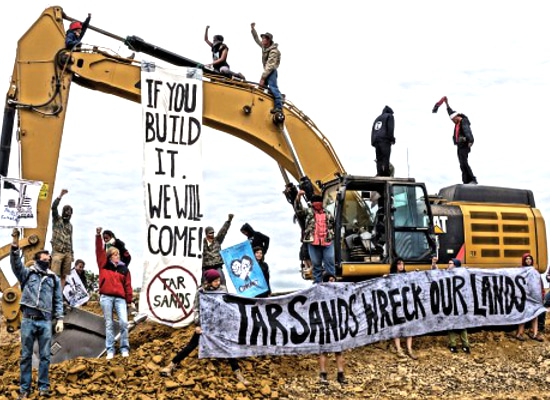While many environmental advocates urge consumers to buy local, in this case, local isn’t always better. While the Canadian tar sands are more notorious, developments here in the US are moving forward as local governments issue more permits to allow companies to start mining.
More than half of the U.S. tar sands resources in active play are in Utah. As DeSmog reported previously, the first US tar sands mine was approved in Utah back in October 2012, with plans to seek a few more permits and begin construction in 2013. After the Utah Water Quality Board approved the permit, the Utah Division of Oil, Gas and Mining also gave the operation the green light to move forward with production.
Since then, US Oil Sands Inc., the company developing the land for extraction, is marching forward. According to exploratory analysis, the 5,930 acres under lease contain approximately 184.3 million barrels of oil. That’s not including over 26,000 acres that weren’t evaluated in the report.
“Based on the [report] and the positive results provided by our exploratory drilling program, we are able to credibly showcase the potential our Utah properties hold for the company and demonstrate that we are one step closer to execution of the first phase of development of PR Spring,” announced CEO Cameron Todd in an earlier report, “…detailed pit planning is now underway in these locations.”
The company plans to be commercially operational by 2014.
But environmental groups are skeptical of the project despite its claims to be a cleaner version of its Canadian sister operation.
Groups such as Western Resource Advocates, Living Rivers, Southern Utah Wilderness Alliance, the Center for Biological Diversity, and other local groups challenge the industry hype that the oil will be any more “environmentally friendly.” Concerns have been raised about the effect the mines will have on air and water quality, wildlife and the natural ecosystem, and also climate change.
“This citizen intervention is necessary because the Department of Interior is sending mixed messages to the public. On one day, the administration issues a statement that the Colorado River’s critical water supply will be protected for people and habitat, and then on another day they announce the most carbon intensive mining practice on the planet can move forward,” said John Weisheit, conservation director with Living Rivers back in late July. “The two programs are not mutually beneficial. Interior has to protect the Colorado River, there is no other choice.”
Advocacy groups have filed a barrage of lawsuits to attempt to shut down the mining operations. Western Resource Advocates filed an appeal to the UWQB permit of PR Springs contesting that there is a real danger in polluting groundwater. The appeal is still under review, but in the meantime, more lawsuits have been filed.
In July, Grand Canyon Trust, Living Rivers, Southern Utah Wilderness Alliance, Rocky Mountain Wild, Biodiversity Conservation Alliance, the Center for Biological Diversity and Sierra Club filed a lawsuit in Colorado courts challenging the tar sands operations in not just Utah, but also Wyoming and Colorado as well.
“Vast mining, carbon emissions and water use will only worsen climate disruption and Colorado River drying,” said Taylor McKinnon, director of energy with the Grand Canyon Trust. “This plan opens the door to that kind of development, and it does so while ignoring the plight of the creatures most vulnerable to its many impacts.”
The suit by the seven groups asserts that 800,000 acres of land have been set aside for tar sands development without heeding to laws pertaining to protecting endangered species.
As legal battles take time, other methods of citizen resistance have cropped up to challenge attempts to develop the land.
Multiple environmental coalitions, including Canyon Country Rising Tide and Peaceful Uprising, organized 50 to 60 protestors at one of the mine sites and shut down operations. Participants chained themselves to heavy machinery in acts of civil disobedience, although reportedly no arrests were made.
Apparently investors noticed, as after the protest, the value of company stock dropped 13%.
From KCSG.com,
“US Oil Sands stock price on the Toronto Stock Exchange closed July 26 at $0.115. As people rolled-out onto the mine site in the Book Cliffs of Utah to enforce a full-day work stoppage, US Oil Sands stock price had dropped to $0.10 (source: Toronto Stock Exchange), down 50% from the company’s 52-week high.
‘Investors have taken notice that these tar sands and oil shale projects in Utah will be made impossible,” says Peaceful Uprising’s Melanie Martin. “The fools-gold nature of these resources, the dangerous potential to poison air and water as well as the people’s drive to prevent their progress all add up to an investment blackhole.’ “
Groups such as Before It Starts continue to organize local communities, and many indigenous communities are also mobilizing against expanded tar sands extraction.
So will U.S. tar sands become a fuel of our future, or will concern about potential impacts give reason for pause? The answer in Utah remains to be seen, but in the meantime, more tar sands operations are cropping up in other parts of the US. We’ll cover those in upcoming posts.
Photo Credit: Peaceful Uprising
Subscribe to our newsletter
Stay up to date with DeSmog news and alerts






